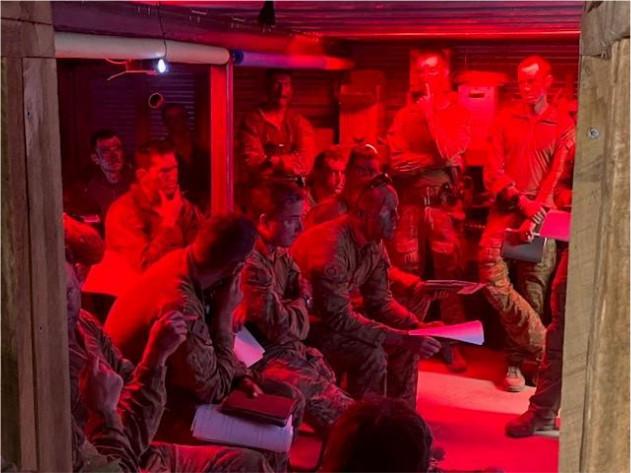Military command relationships are essential to the effective functioning and success of military operations. These relationships define the authority, responsibility, and accountability of commanders over their assigned forces, shaping the decision-making process, operational effectiveness, and coordination among various military units. Understanding these relationships is crucial not only for maintaining order within the military hierarchy but also for achieving strategic objectives and ensuring seamless communication and cooperation among different units. This article examines the key aspects of military command relationships and highlights the importance of understanding them, with a particular focus on the Brigade’s part within the Division as the unit of action.

Defining Military Command Relationships
Command relationships refer to the formal and informal structures that define a units force elements, organisation, control and coordination mechanisms to achieve a mission. These relationships are characterised by different levels of authority, including both command and control delegations. Operational command (OPCOMD), tactical Command (TACCOM), operational control (OPCON), tactical control (TACON), administrative control (ADCON), support relationships and direct liaison authority (DIRLAUTH) are the most relevant to the Brigade. Each level has distinct responsibilities and authorities with a brief summary of each provided below:
- Operational Command (OPCOMD): This grants a commander full authority to assign missions, task forces, and control units to accomplish the assigned mission within the allocated operation. This is the highest level of operational authority, enabling the delegation of command relationships outlined below. This type of command relationship is crucial for strategic-level operations where commanders need the flexibility to allocate resources and direct forces effectively. OPCOMD is typically held at the joint task force level for major operations.
- Tactical Command (TACOMD): This grants a commander authority to assign missions and tasks to forces under their command. This is most relevant to the brigade when operating in a single-service environment and is generally the highest level of authority provided to non-ADF commanders over Australian subordinates.
- Operational Control (OPCON): This grants a commander the authority to organise and employ forces as required to accomplish assigned missions. OPCON is typically limited by time and function, focusing on the operational employment of units rather than their administration or logistics.
- Tactical Control (TACON): This is more limited than OPCON and is focused on the detailed and local direction and control of movements or manoeuvres necessary to accomplish specific tasks or missions.
- Administrative Control (ADCON): This involves the administration and support of units, including matters such as personnel management, logistics, and training. It does not necessarily imply authority over operational employment. ADCON is primarily used within the RAN, with relevance to a Brigade within a joint environment.
- Support Relationships: These are less defined in terms of authority and focus more on coordination. A support relationship might exist when one unit provides necessary support to another, such as logistics, air support or direct and in-direct fire support, without transferring command authority.
- Direct Liaison Authorised (DIRLAUTH): DIRLAUTH allows direct coordination between units without going through the usual chain of command. It is a more informal relationship used to expedite coordination and information sharing, particularly in complex, fast-moving operations where time is of the essence. While it facilitates communication, it does not imply command authority.
These distinctions are crucial for the clear allocation of responsibilities, ensuring that all elements of the military force understand their roles and the chain of command. This clear understanding helps prevent overlaps, conflicts, and confusion during operations.
The Importance of Understanding Command Relationships
Understanding military command relationships is vital for several reasons:
Clarity of Command and Unity of Effort
In complex military operations, especially those involving joint or combined forces, command relationships clarify who is in charge and who is responsible for what aspect of an operation. This clarity ensures that all units work towards the same objective without conflicting orders or duplication of effort. Understanding these relationships helps align the actions of different forces, ensuring a cohesive and effective approach to mission accomplishment. Deliberate coordination is key to achieving this unity of effort, as evident throughout the BROLGA Series in 2024. Different units may come from various coalition branches of their respective military, such as the army, navy, air force, or marines each with its own command structures and operational philosophies. Clear command relationships help integrate these diverse elements, ensuring that all forces work towards a common goal without duplication of effort or conflicting objectives. As noted by Kilcullen (2009), effective coordination between different units and branches is essential to countering contemporary threats, which often require a multifaceted approach.
Efficient Resource Allocation
Clear command relationships also facilitate efficient resource allocation. By clearly defining who is in charge and what their responsibilities are, brigade planners can ensure that critical resources such as personnel, equipment, and logistics support are prioritised and directed to where they are most needed. This is particularly important in environments where resources are limited, and rapid decision-making is required. According to Grey (2011), the effectiveness of the ADF in overseas operations often hinges on the ability to swiftly allocate resources in response to evolving situations, which is only possible with a clear understanding of command relationships.
Enhanced Decision-Making
Command relationships provide a framework for decision-making by delineating authority and responsibility. In a high-pressure environment, where quick and decisive actions are often necessary, having a clear chain of command enables faster decision-making, generating greater tempo. It reduces ambiguity and ensures that decisions are made by those with the appropriate authority and situational awareness. As articulated by Kille and Scully (2019), the clarity of command and control structures is crucial in crisis situations, where delays or indecisiveness can lead to mission failure or unnecessary casualties.
Legal and Ethical Accountability
Military operations are governed by strict rules of engagement and international laws, which necessitate clear accountability. Understanding command relationships helps delineate who is responsible for what actions, ensuring that there is accountability for decisions made and actions taken. This is crucial not only for maintaining discipline across the brigade but also for adhering to international legal standards. As discussed by Biddington and Cannizzo (2008), the ADF's commitment to international norms and legal frameworks underscores the importance of clearly defined command relationships, which help prevent unlawful actions and uphold ethical standards.
Joint Operations Command
The establishment of Joint Operations Command (JOC) reflects a commitment to integrated command and control. JOC is responsible for planning, controlling, and conducting operations on behalf of the Chief of Defence Force. This integrated approach ensures that the ADF can deploy and operate effectively across different environments, whether on land, at sea, or in the air. The enables the allocation of finite recourses as discussed above to the most appropriate theatre, unit of action, or even as low as a particular force element. According to Brangwin and Townsend (2016), the JOC's role in harmonizing the efforts of different services, and coalition branches underscores the importance of understanding and implementing effective command relationships.
Coalition Operations
The ADF frequently operates as part of multinational coalitions, where understanding command relationships becomes even more crucial. In coalition operations, ADF units may come under command of foreign commanders, or vice versa. Clear command relationships help establish the terms of these arrangements, ensuring that all parties understand their roles, responsibilities, and the limits of their authority. This can include clearly defined national caveats that may constrain or restrict the freedom of action for each force element. Clarity is vital for maintaining trust and cooperation among coalition partners, as highlighted by the ADF's experiences in operations such as those in Afghanistan and Iraq (Ryan, 2009).
Challenges and Future Considerations
While the importance of understanding command relationships is clear, challenges remain. As military operations become increasingly complex, involving a wider range of actors, from non-state actors to private military contractors, the traditional command relationships may need to adapt. Moreover, the growing role of cyber and space domains in warfare introduces new dimensions to command relationships, requiring a re-evaluation of existing frameworks. As Leahy (2015) notes, the ADF and other military forces must continuously adapt their command structures to remain effective in the evolving strategic environment.
Conclusion
Command relationships are fundamental to the effective functioning of any armed force. They provide the structure necessary for coordination, efficient resource allocation, decision- making, and accountability. Understanding these relationships is crucial for military commanders and planners, particularly in complex and dynamic operational environments. For the brigade, clear command relationships are essential for successful joint and coalition operations, ensuring that all elements of the force can work together harmoniously to achieve strategic objectives. As the nature of warfare evolves, so too must the understanding and implementation of command relationships, ensuring that they remain fit for purpose in the face of new challenges.
LTCOL TJ Hawley
COS 3 BDE
References
Australian Defecne Force – Philosophical – 0 Command, edition 1, 24 Jan 2024
Biddington, J., & Cannizzo, F. (2008). Ethical Dilemmas in Peace Operations. Australian Defence Force Journal, 175, 21-30.
Brangwin, N., & Townsend, J. (2016). Joint Operations Command and the Australian Defence Force. Parliamentary Library, Department of Parliamentary Services.
Chase, M. (2019). Achieving Unity of Effort in Joint Operations: A Framework for Success. Joint Forces Quarterly, 93(2), 56-63.
Grey, J. (2011). A Military History of Australia. Cambridge University Press.
Kilcullen, D. (2009). The Accidental Guerrilla: Fighting Small Wars in the Midst of a Big One. Oxford University Press.
Kille, K. J., & Scully, R. M. (2019). Leadership and Responsibility in UN Peacekeeping Operations: A Case Analysis of the Australian Defence Force. International Peacekeeping, 26(5), 620-644.
Leahy, P. (2015). The Future of the Australian Army. Australian Strategic Policy Institute.
Ryan, A. (2009). Counter-Insurgency and Civil Military Cooperation: Winning Hearts and Minds? Routledge.
Ryan, M., Smith, J., & Jones, A. (2020). Military Command and Control: Theory and Practice. Canberra: Australian National University Press.
Smith, D., & Jones, R. (2019). Joint Operations and Command Relationships in the ADF. Sydney: University of New South Wales Press.
Thompson, L., & Williams, M. (2021). Decision-Making in Military Operations: The Role of Command Relationships. Melbourne: Defence Science Institute.









